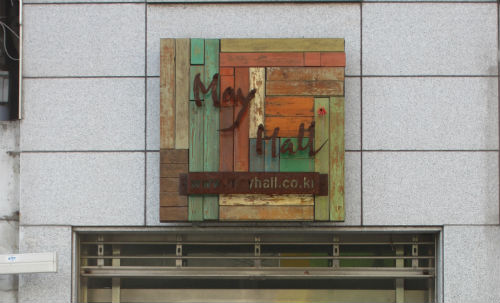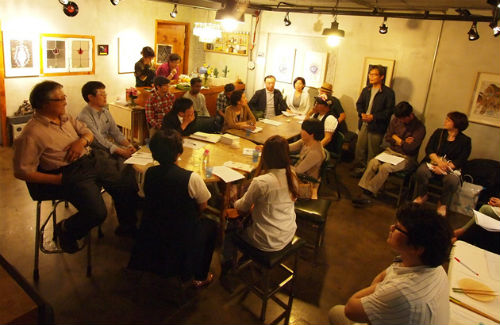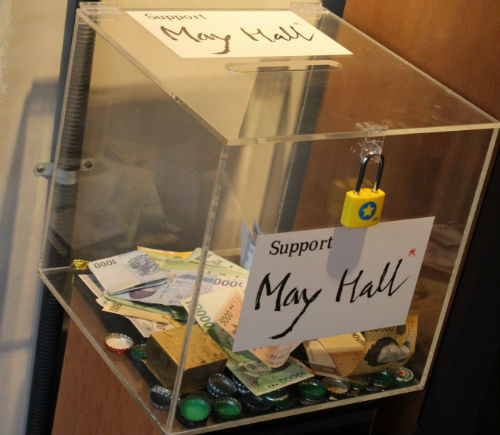
What is the first image that comes to your mind when you think of May? Many people think of the May 18 Gwangju Democratic Uprising in which citizens resisted a military regime in favor of democracy by fighting against soldiers and spontaneously providing rice balls to the protesters. To honor its spirit of democracy and cooperation, some citizens have run a small and humble cultural art space named ‘May Hall (MH)’ on Munhwajeondang-ro. Let’s take a look at the hall, wherein you can enjoy many different cultural activities such as exhibitions, concerts or cultural classes.

Exhibitions
The MH has a nickname, “a novel and unique cultural place”, and it focuses on alternative culture rather than mainstream or popular culture. When this reporter visited the hall, there were two exhibitions by Hong Seong-dam’s “Bari” and Haru. K’s “Delicious Scenery: Spring, Summer, Fall and Winter” both held from April 1st to 10th, 2014. With Princess Bari as a lead character, painter Hong who is a representative folk painter and was in the civil propaganda squad in May, 1980, described a decade of his dreams by drawing pictures and writing books in order to search for something operating in his own inner world. Hong supported Haru’s exhibition to encourage junior artist’s creativity. Ju Hong is the curator of the hall and guides artworks on display to people. She said, “Hong’s work is the type of therapeutic arts that cures people persecuted by governmental forces. His art corresponds well with the civic spirit which the MH emphasizes.”
Last year, it offered “Les Miserables” which was a guerrilla exhibition based on citizen participation in collaboration with France’s Alliance Francaise Gwangju and displayed paintings, pictures and installation works using the French daily newspaper, Le Monde’. Also, the traveling collection by Yim Eui-jin and the exhibition “Nine Bullets” by Hong Seong-dam were shown. A special display by cartoonist Park Jae-dong is going to be taking place from May 16th to 23rd, 2014. These exhibitions are being displayed on the 2nd and 4th floors of the hall.

Music, Classes and Talk
The MH provides the opportunity to be social with local residents. People can also listen to acoustic folk music here. Folk musicians such as Kim Du-su and Choi Go-eun have held small concerts periodically. On the 5th floor, cultural lectures about literature, sketch, modern art, photography, guitar, coffee and so on are given by artists. In addition, it has also provided room for Asian Talks where one speaker gives a lecture and Koreans and foreigners have a monthly discussion about a specific topic, such as Asian human rights or Asian cultures. When special events like Asian Talks are held, people gather in the cafe on the 3rd floor, cook some food and share together. While enjoying culture in the MH, they communicate with each other and can be friends.
The representative Park Seok-in said, “It is deplorable that the sense of community is disappearing recently. For our next generations, at least in Gwangju we have to share meaningful values, pursue coexistence, and strive to form a cooperative global village in order to restore a collapsed community. I hope many people communicate and interact with each other freely in spontaneous places like the MH.”

Autonomous and Alternative Place
Unlike other culture and art centers, the MH has a unique feature, a small group named ‘Warm Gathering’ composed of around 15 members set up this hall altogether. Also, it is managed by citizens’ voluntary support. Its managers promised that they will run the place only under the patronage of ‘citizens’, not with any budget by ‘officials’. The cost for preparing activities has been all paid by the Warm Gathering’s membership fees and citizens’ donations. It really realizes “Every Little Helps”. This aspect is compared to the huge Asian Culture Complex being built next to it at a cost of hundreds of billions of won.
The MH is also an alternative place for promoting cultural diversity. These days, people who deviate from regular thinking are likely to be treated unfairly and not permitted. Many galleries already exist, but they are commercial or organized by government. Some artists who have their own different perspectives or who want to exhibit but have no place to display their works need an exhibition space. For them, it is a proper place.

Enrich Our Sense of Community and Culture
Gwangju still has a poor cultural infrastructure and difficulty in operating spontaneous cultural programs, but this place shows a bright prospect as an autonomous alternative place. Curator Ju said, “I think that if such activities as the MH occur here and there, warm human affection will spread into the whole community. What we are doing is very modest. The most important thing is spontaneity. I wish that individuals will join forces to improve the level of culture in Gwangju and have a mature sense of citizenship. Until that day we will have these cultural programs.” Now the MH is providing distinguishing programs and engaging in various activities to enrich the culture of Gwangju and to admire the spirit of the May 18 Uprising which is still alive in our mind through the arts. It is meaningful that these things are all done autogenously by citizens’ willing participation. How about visiting the hall this month with your friends or acquaintances?
By Lee Da-hye, Tribune Reporter

